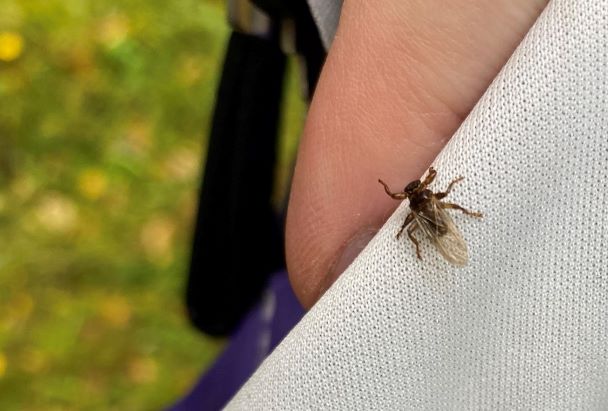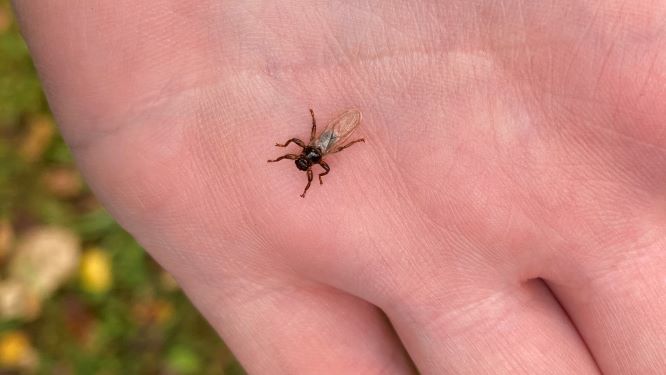Deer keds (Lipoptena cervi) are usually found on deer, elk and moose, but occasionally bite humans and domestic mammals. They are those annoying little insects that fly directly on to you in autumn forest, crawl into your hair and drop their wings like they have finally found the moose they were looking for. Deer keds, known as hirvikärpänen (=literally moose fly) in Finnish, look like a mix of spiders and flies. They have long wings but they are flat and elastic. And annoying as hell.
The deer keds emerge from the soil each fall, usually in August or September. They look for a host and after they have landed on one, they immediately shed their wings, happy to stay on that same host for the rest of their lives. Females produce just one egg at a time inside of them, and when the larva is almost fully developed, it drops to the soil and forms a pupa, eventually emerging as a winged adult at the end of August. Both males and females suck blood.
The adult deer ked is looking for a host mainly by warmth. Therefore, they mistake humans or even dogs as moose sometimes. The main annoyance in humans is the inconvenience and unpleasantness of removing keds from hair and clothes. But they can also bite and cause intense itch. It is still unknown whether they can transmit diseases, but the fact that they easily drop their wings in the host means that their capability to transmit diseases from animals to humans is limited. In Sweden the deer ked has been documented since the 18th century, but in Finland it started spreading in the 60s. It might have been here before, but started spreading more because of large deer and moose populations. Remains of deer ked have even been found in Ötzi, the natural mummy of a man who lived sometime between 3400 and 3100 BCE and who was found in the the Ötztal Alps in 1991. Poor Ötzi, not only was he murdered but he suffered from the deer keds too.
Interestingly, the deer keds in Sweden use roe deer as their main host instead of moose. The Swedish deer keds are smaller in size and less annoying to humans.

One moose can carry even 10 000 deer keds on itself. I recently stumbled into a resting spot of a moose and was hit by tens of deer keds instantly. Recent research made in Finland found that some birds, especially tits, preferred to stay close to deer ked infected moose and their resting spots as the tits utilized deer ked pupa as their alimentation. This had a limiting effect on deer ked population in that area the following year.
One concern in Finland has been if the deer keds spread into Lapland and to reindeers. At the moment it seems that they can be found in reindeers close to the arctic circle but they cannot effectively reproduce in them. Which would be good because they annoy the hell out of reindeers, too. I once found a deer ked-like creature in my head in Lapland I was freaking out that they have spread there too, but it turned out to be another insect, a bird ked. Slightly smaller in size and lighter color than the deer ked. Some people who claim to have seen deer keds as early as in June in Finland may in fact have found these bird keds. They are similar, but the bird keds don’t drop their wings and they are not known to bite humans. They are active early in the summer when birds fly out from their nests.
What is the difference between deer ked and tick?
Ticks and deer keds are both types of ectoparasites that feed on the blood of animals, including deer and sometimes humans. However, deer keds do not embed themselves in the skin like ticks, and they are less likely to bite humans. Read more about ticks from our post: All you need to know about ticks in Finland
How to get rid of the deer keds?
Some people avoid going to the forest in the autumn after the deer keds appear. Some may have severe allergic reaction to their bites and must be careful because of that, but many just find them so unbearably annoying.
Unfortunately, there is no simple solution for the annoyance of the deer keds. Camphor drops were believed to expel them at the old days, but that hasn’t been scientifically proven. Some people still recommend that even today. You can also buy a deer ked repellent Hirvikärpässtop, but I have soaked myself in it with zero effect on the deer keds. Some people believe that white or light-colored clothing would be better, but I personally believe they are better only because you can spot the deer keds easier on white and pick them away from your clothes. You can use mosquito net hats or jackets and cover yourself from head to toe like a bee keeper, but the deer keds are vicious little creatures and they somehow always crawl inside of your protective outfit eventually. And then it’s even harder to pick them away from your skin when they are under your net. Some people suggest that since ants are the natural predators of the deer pupa, formic acid from ants’ nest could work as repellent. Some believe in the power of garlic. And one person even recommended shaving your head.. Covering yourself with light-colored long sleeve clothes and a hat and net might still be your best bet. And antihistamine and resin cream in case you get bitten.
Killing the deer ked isn’t easy either. They simply won’t die. One positive thing about cold winter is, that it stops the deer keds from flying and you can relax in the forest again. But they can survive even in -15 degrees and fly again if the sun warms them up. As the deer keds love deer and moose, the best strategy would be to limit the amounts of their hosts. Suddenly a wolf in a nearby forest is not such as bad thing.
My record so far is 17 deer keds on my hair, can you beat that? I needed a beer keg after that hiking trip!
Read also
- Deer and moose populations affect the number of deer keds out in the nature. Read more about deer hunting and moose hunting in Finland.
- All you need to know about ticks in Finland


I think I had more of them on me during visits to forest (Poland). I have some observation on the topic: I’m sweating a lot, comparing to my companions, thus I was more affected (body temperature, smell, pheromones?). Reppelents didn’t work at all, I even noticed increased activity of keds after using some. I have tested several times very popular one “mugga” and keds didn’t seem to bother about it when was spraying them on my skin. Color of the clothes was not taken under their consideration as well, bright or even white clothes were only helpful for me to find keds easier. The most intensive attacks were in places where heath, blueberries and pine trees were together. But unfortunately they are present in almost all places except dry forest, with barren, sandy ground/soil where their swarm attack is not so intensive. They’re a nightmare for me, cause ususlly they bite me in the back of the head where skin in thicker. Wounds heal very long, not very painful but annoying Their high season in Poland is August-September-October Looking for some solution…help…
I have similar experiences, I think they like some people more than others. Heat is definitely one thing they are drawn to, but maybe also size. Larger person seems to attract them more than the kids. For me the best solution has been a net jacket, together with other clothing closed tightly around the wrists and waist. This is not an ad, but I use this kind of jacket: https://www.motonet.fi/fi/tuote/5503840/JahtiJakt-hirvikarpastakki. It helps for a while. Sometimes they still manage to get inside the jacket, and that makes it even worse.
Yeah. I’ve had the same experience with those creatures from hell. Exactly the same, and also in Poland. They started to appear some 5,6 years ago and since then I haven’t been able to go to the woods without my ‘protective gear’. I use a work suit, a kind of onesie, with sewn mosquito net for the head. To make the suit impossible for them to crawl in but bearable for me I added a zipper so I can open the net part easily. Like you said, repellents don’t work. DEET seems to attract them. Moreover, sprayed directly on such bug doesn’t do any harm to it at all. The sweating part seem to be also true, so I assume their sense of smell is quite good and they target strong smells. Therefore, I use salvia extract, alcohol based, and apply it on the skin before going to the woods (blocks sweating). Seems to work to some extent. With those light colours that people claim to be helpful, I must disagree. Once I went to a ked free forest (I thought so) with dark coloured clothes but took a silvery white/grey bag. Keds targeted mostly the bag. I guess maybe they targeted something that resembles deer ‘butts’. So for my onesie I chose red. I don’t think they associate it with sth edible. Now I’m preparing a onsie for my little daughter, as I would like her to be able to enjoy nature. But since last week I took one of those nice guys out from the inside of my ear, I have to protect her because doing the same to a little child would be rather difficult. And contrary to what you can find on the internet, I belive keds do transmit diseases to humans. In some parts of Poland they don’t shed wings (there are 2 species/kinds) and can fly from prey to prey. I once got ill after some bites. Flu like syptoms and severe neurological ones (blurred vision,dizziness, legs patesthesia). Antibiotic helped. On other occasions it was only alergic reaction. I think it may be like with ticks. In some areas they are infected, in others they aren’t. Hope somebody finds some kind of effective repellent one day. If it happens, let me know, please
I’m currently testing this new Finnish product called MetsäDeo. I’ll let you know if it works.
HI! Have you tested MetsaDeo already? How did it work?
Yes! One time I had about 20 deer keds on my clothes but none of them went into my hair. I was wearing a beanie sprayed with MetsäDeo. The smell of the product is overwhelmingly bad, so I haven’t used it again as the deer ked situation has been more tolerable. I don’t honestly know which one is worse, the deer keds or the smell of MetsäDeo. I can’t be sure yet that it works, but it would repel me, for sure.
Interesting, didn’t know that the deer flies are friendlier in Sweden :). But I very much dislike our own deer flies. However, my experiences have been – or at least I think so – that when wearing light colors they are not so interested in me. Dunno if that’s the real case or am I just imagining 🙂 .
Thanks for sharing your experiences. I certainly hope lighter colors help as nothing else seems to.
This year they have been horrible here in the US Northeast Pennsylvania area. Just this morning while on a hunt I have killed minimally 20 in a 90 minute time frame. So much so I left the woods and went to get some bug repellent. If it works I will repost. Also I have read tea tree oil has been affective. If this lotion doesn’t work I will try that next.
I would love any repellent that truly works. Even better if it’s a natural remedy. Keep us posted!
Probably the most annoying creatures in the woods. I call them “asshole flies”, and whoever has encountered these pests immediately knows what I refer to. I’ve read they have good eyesight as well, but again these might have been speculations. One thing is for sure: it’s good that they are only active during a small part of the year.
I live in the south Hungary and often end up literally running through the forest with my dog to try to get away from the kedd flies. They send my dog crazy and we take great pleasure in killing them every which way we can.
It is the worst when there is a swarm of them!
Currently I’m in the Swedish woods in the Örebro region. These evil species really wreck my vacation time in the forest. There are so much of them, never experienced something like this in Germany.
I can definitely confirm that the keds are attracted by DEET. One day I put DEET on my skin because of the mosquitoes. But suddenly I’ve got a lot of keds on me.
Set up my camp at a lake instead in the forest definitely helps for the evening and the morning. Seems that there aren’t any keds around lakes. Light colors does not help!
So, this year I had deer keds, mosquitoes and a loooot midges in Scotland. Anything else?
Looking forward for the winter!
It’s interesting that they are attracted by DEET. Since we cannot repel them, can we create a trap? I’m now considering ruining one of my caps with double-sided adhesive sticky tape. That tape should stop them.